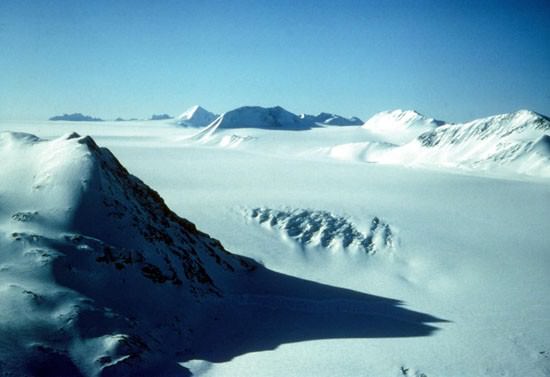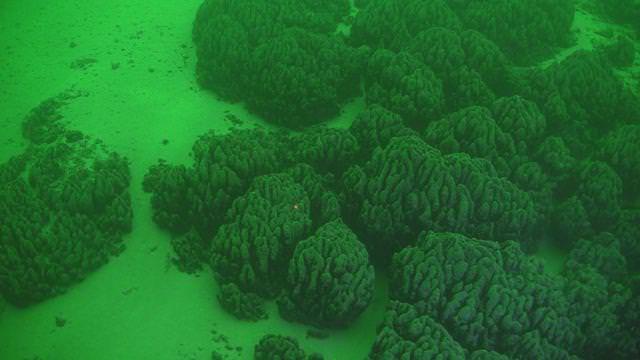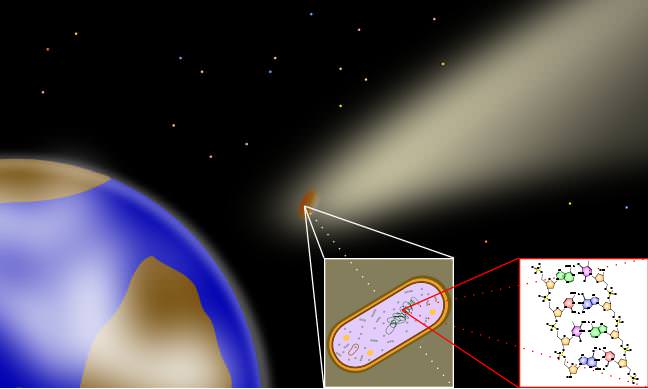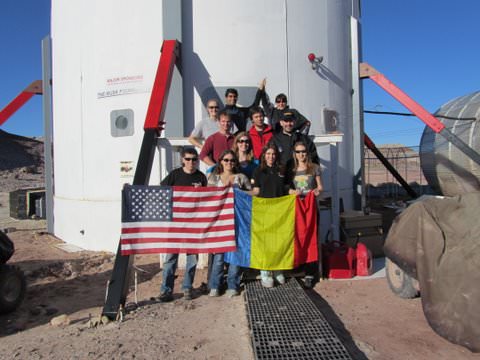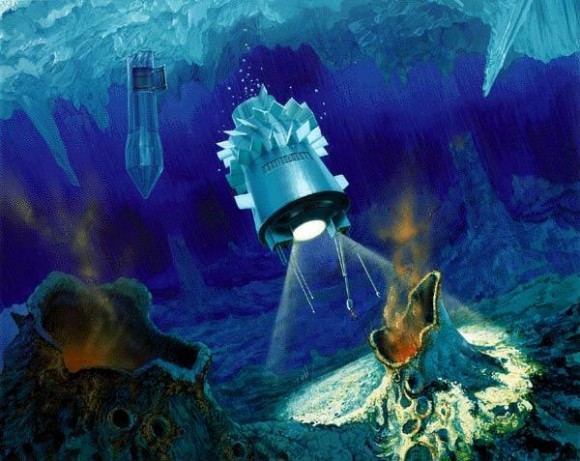A new NOVA show airs tonight (October 19) in the US on public television, called “Finding Life Beyond Earth.” It includes interviews with many big names in planetary science and like any NOVA show, should be excellent. PBS has a great website that goes along with the show, and for those of you that don’t live in the US or get a public television station, PBS usually posts the videos of NOVA shows online later. Above is a trailer for the show. Check your local listings for when it will air; if you miss it first time around, local stations will sometimes re-air the show during the middle of the night!
Life In A Slice Of Ice
[/caption]
Thanks to a grant from the National Science Foundation, a University of Washington doctoral student named Adam Campbell has been conducting a research on photosynthetic algae. While this simple, light-loving form of life might not seem very important, it very well could have survived the global ice age by hiding in an area similar to the Red Sea.
“Under those frigid conditions, there are not a lot of places where you would expect liquid water and light to occur in the same area, and you need both of those things for photosynthetic algae to survive,” said Campbell.
How could this slice of ice endure against the massive force of a glacier? If there was a thin body of water about six and half times longer than it was wide, it would be possible for it to create enough physical resistance to stop a moving ice sheet. Chances are good that the ice would vaporize before it reached the end of the sea. This means at least enough open water for algae to survive.
“The initial results have shown pretty well that these kinds of channels could remain relatively free of thick glacial ice during a ‘snowball Earth’ event,” Campbell elucidates.
Through the use of an analytical model that simulates environmental conditions theorized to exist somewhere between 800 million and 550 million years ago, Campbell and his team of Edwin Waddington and Stephen Warren, UW professors of Earth and space sciences, were able to simulate ten million years of deep freeze. Their timeline began before the Cambrian explosion about 530 million years ago when Earth quickly changed tactics and became more heterogeneous. However, simple photosynthetic plankton have made their presence known in the records both before and after this studied time period… a presence which made scientists wonder how it could happen if the Earth had been totally covered in ice.
Campbell said it is assumed the algae survived these episodes, “unless they re-evolved each time, which creates a whole different problem for evolutionary biology.”
Why chose the Red Sea as an example? Quite simply put, because it’s perfect. It formed from a tectonic process called continental rifting, existed in the right time line and was correctly globally positioned. Campbell also noted that in a snowball Earth event, the exposed sea would have quickly evaporated if there weren’t a method of refill – such as created by a dam of glacial ice. Just a small amount… like enough to last 10 million years for the algae to take hold.
“Over 10 million years, you could evaporate the deepest lake in the world,” Campbell said. “If you’re in a desert, you’d have to have a supply of sea water.”
Original Story Source: University of Washington News.
Citizen Science: Help Find Life on Mars
[/caption]
Interested in helping NASA scientists pinpoint where to look for signs of life on Mars?
If so, you can join a new citizen science website called MAPPER, launched in conjunction with the Pavilion Lake Research Project’s 2011 field season.
How can the MAPPER and Pavilion Lake Research projects help scientists look for off-Earth life?
Since 2008, the Pavilion Lake Research Project (PLRP) has used DeepWorker submersible vehicles to investigate the underwater environment of two lakes in Canada (Pavilion and Kelly). With the MAPPER project, citizen scientists can work with NASA scientists and explore the lake bottoms from the view of a DeepWorker pilot.
The PLRP team’s main area of focus are freshwater carbonate formations known as microbialites. By studying microbialites that thrive in Pavilion and Kelly Lake, the scientists believe a better understanding of how the formations develop. Through a greater understanding of the carbonate formations, the team believes they will gain deeper insights into where signs of life may be found on Mars and beyond.
To investigate the formations in detail, video footage and photos of the lake bottom are recorded by DeepWorker sub pilots. The data requires analysis in order to determine what types of features can be found in different parts of the lake. Analyzing the data allows the team to answer questions such as; “how does microbialite texture and size vary with depth?” and “why do microbialites grow in certain parts of the lake but not in others?”.
The amount of data to analyze is staggering – if each image taken were to be printed, the stack would be taller than the depth of Pavilion Lake (over 60 meters). If each image were reviewed one-by-one, the PLRP’s team would never be able to complete their work. Distributing the work to the general public solves the problem, due in part by spreading the massive work out over many volunteers across the Internet.
Since the PLRP 2011 field season Morphology Analysis Project for Participatory Exploration and Research (MAPPER) MAPPER has been open to the general public. By opening MAPPER to the public, anyone can explore Pavilion and Kelly Lake as full-fledged members of PLRP’s Remote Science Team.
So how do volunteers use MAPPER to help the PLRP team?
Once volunteers create an account at: getmapper.com, the volunteers complete a brief tutorial, which provides the necessary training to tag photos in the PLRP dataset. MAPPER has ease-of-use in mind, providing users with a simple interface, which makes tagging features like sediment, microbialites, rocks, and algae easy. In case a user is unsure of how to tag a photo, examples and descriptions of each feature are available.
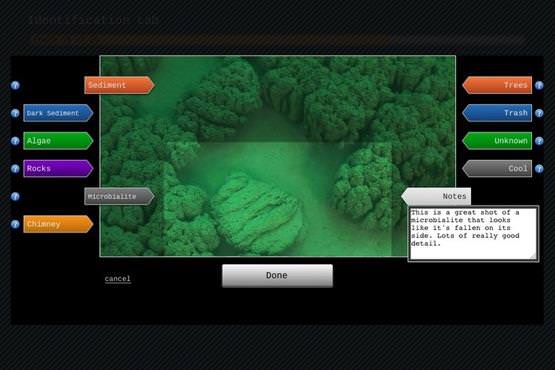
In a manner similar to online games, each photo tagged earns the volunteer points which can be used to unlock new activities. Volunteers can also compete with other Remote Science Team members on the MAPPER leaderboard. Volunteers can also check to see how close each dataset is to being completely reviewed and see how much they have contributed to said dataset, as well as seeing what features have been tagged the most. Volunteers who tag a photo as ‘cool’ save said image to their Cool Photos album, allowing them to easily find the image at a later date.
PLRP Remote Science Team members from across North America, Europe and Asia have already been making discoveries in Pavilion and Kelly Lake. If you’d like to become a PLRP Remote Science Team member, visit: www.getmapper.com
You can also learn more by visiting the MAPPER Facebook page
Earth Could Spread Life Across The Milky Way
[/caption]
Most of us are familiar with the concept of panspermia – where living organisms can be “seeded” from comet or asteroid impacts – but where does the life-giving content come from? According to a research group led by Mauricio Reyes-Ruiz from the National Autonomous University of Mexico, it just might come from Earth.
Inspired by the discovery of Moon and Mars rocks found on Earth from meteor strikes, the team began computer modeling of what might happen if pieces of Earth were transported across the Solar System via a collision scenario. The simulation involved 10,000 Earth particles moving over a period of 30,000 years. The amount of matter is tiny compared to the bulk our planet and it’s a blink of the eye in cosmic time, but scientists theorize that extreme lifeforms might be able to exist that long in space.
“The collision probability is greater than previously reported,” said Reyes-Ruiz. “It has been suggested that the ejection to interplanetary space of terrestrial crustal material, accelerated in a large impact, may result in the interchange of biological material between Earth and other Solar System bodies”
Could pieces of Earth really reach other planets? According to older theories, chances were good that some might reach the Moon or Venus, but gravity from the Sun and Earth makes reaching Mars improbable. However, the new simulations show a Mars impact – and even Jupiter – to be probable with the right ejection speeds. By involving slightly more particles at five times the rate of motion, the new results show the particles could even go beyond the Solar System. Oddly enough, the faster they moved, the lesser their chances of encountering the Moon and Venus became. Of the 10,242 tested, 691 particles ‘escaped’ out of the Solar System entirely, and six landed on Jupiter itself. Is this a Neil Young vision of flying Mother Nature’s silver seed to a new home?
Chris Shepherd of the Institute of Physics in London, who was not involved in the study, might agree with this conclusion. “This is an intriguing piece of work. The team have mapped out a really interesting scenario,” he said. One possible collision zone is Europa, the moon of Jupiter, and while the team did not simulate the number of particles that would specifically land there, many astronomers believe that it contains a large ocean, and could therefore support life.”
Original Story Source: Cosmos Magazine News Release. For Further Study: Dynamics of escaping Earth ejecta and their collision probability with different Solar System bodies.
Microfossils Discovered On Earth Could Aid In Finding Ancient Life On Mars
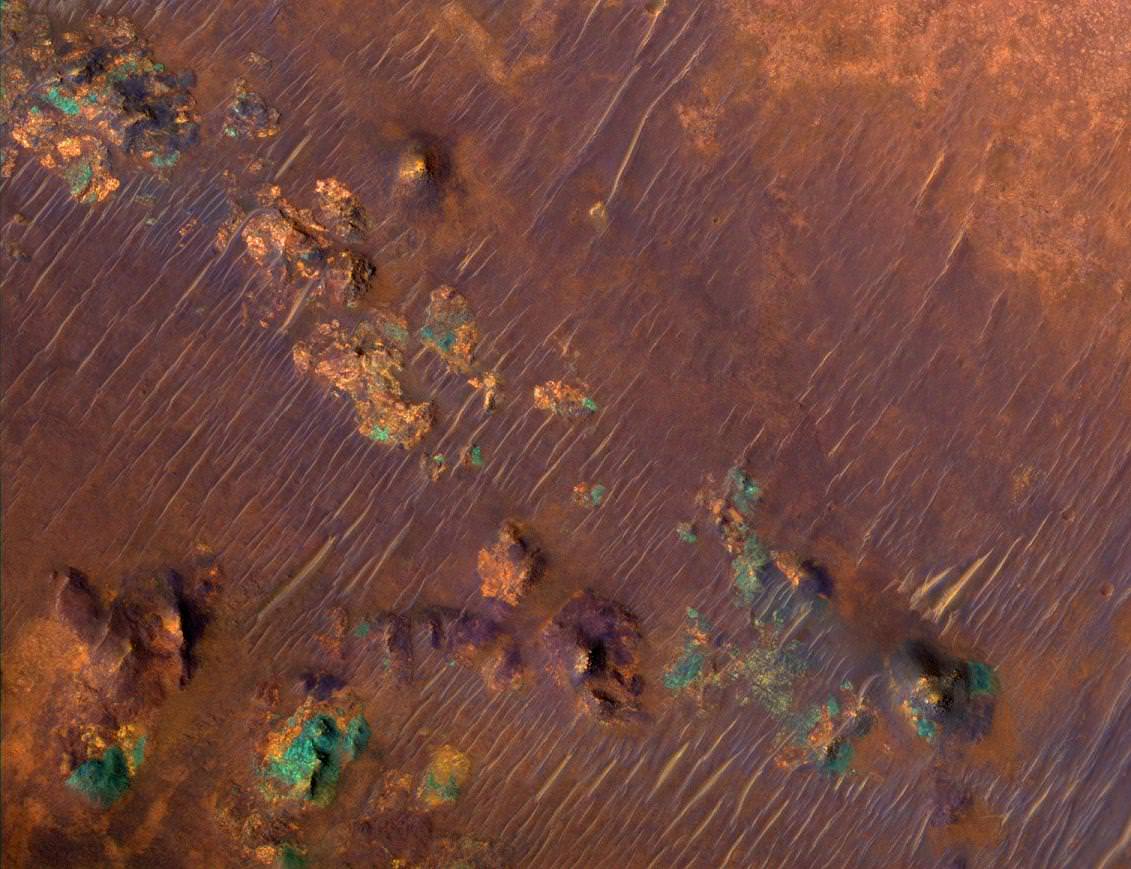
[/caption]
What does a more than three billion year old sandstone formation in Western Australia have in common with Mars? The Aussie stones contain the oldest living microbial record of life on Earth – and it might be the basis of fossil discovery on Mars. The early Archaean rocks are providing geologists with microfossil evidence that early life might have been utilizing sulpher – instead of oxygen – for their ecosystems.
“At last we have good solid evidence for life over 3.4 billion years ago. It confirms there were bacteria at this time, living without oxygen,” said co-researcher Professor Martin Brasier at Oxford University, UK. “Such bacteria are still common today. Sulphur bacteria are found in smelly ditches, soil, hot springs, hydrothermal vents – anywhere where there’s little free oxygen and they can live off organic matter,” he explained.
But providing morphological evidence for these sulphur-metabolizing bacteria hasn’t been as easy as just digging up some stones. The first detection came in 2007 at Strelley Pool, a now arid area which may have once been an estuary or shallow water region. Associated with micrometre-sized pyrite crystals, these microstructures show all the right ingredients for early life properties, such as hollow cell lumens and carbonaceous cell walls enriched in nitrogen. Spheroidal and ellipsoidal forms are good indicators of bacterial formations and tubular sheaths point to multiple cell growth. They also display pyrite content, but there’s no “fool’s gold” here in these light isotopes… it’s a metabolic by-products of the cells.
“Life likes lighter isotopes, so if you have a light signature in these minerals then it looks biological,” said lead author Dr David Wacey from the University of Western Australia. “There are ways to get the same signature without biology, but that generally requires very high temperatures. So when you put together the light isotope signature with the fact the pyrite is right next to the microfossils – just a couple of microns away – then it really does look like there was a whole sulphur ecosystem there,” he reported to BBC News.
So what does this discovery have to do with Mars? In its northern hemisphere is a region called Nili Fossae which photographically bears a strong resemblance to Australia’s Pilbara region – home to Strelley Pool. With a huge amount of clay minerals documented, Nili Fossae just might be the ideal place for US space agency’s Curiosity-Mars Science Laboratory rover mission to begin a search for early Martian life forms. But don’t get too excited just yet… The study on a remote planet is going to prove even more difficult than here on Earth.
“Some of the instruments we used can fill a whole room, but some of them can be miniaturised,” said Dr Wacey. “A rover could narrow down the targets but then you’d really have to bring samples back to Earth to study them in detail.”
Original Story Source: BBC News – Science and Environment and Nature Geoscience.
Tagish Lake Meteorite Delivers Different Composition
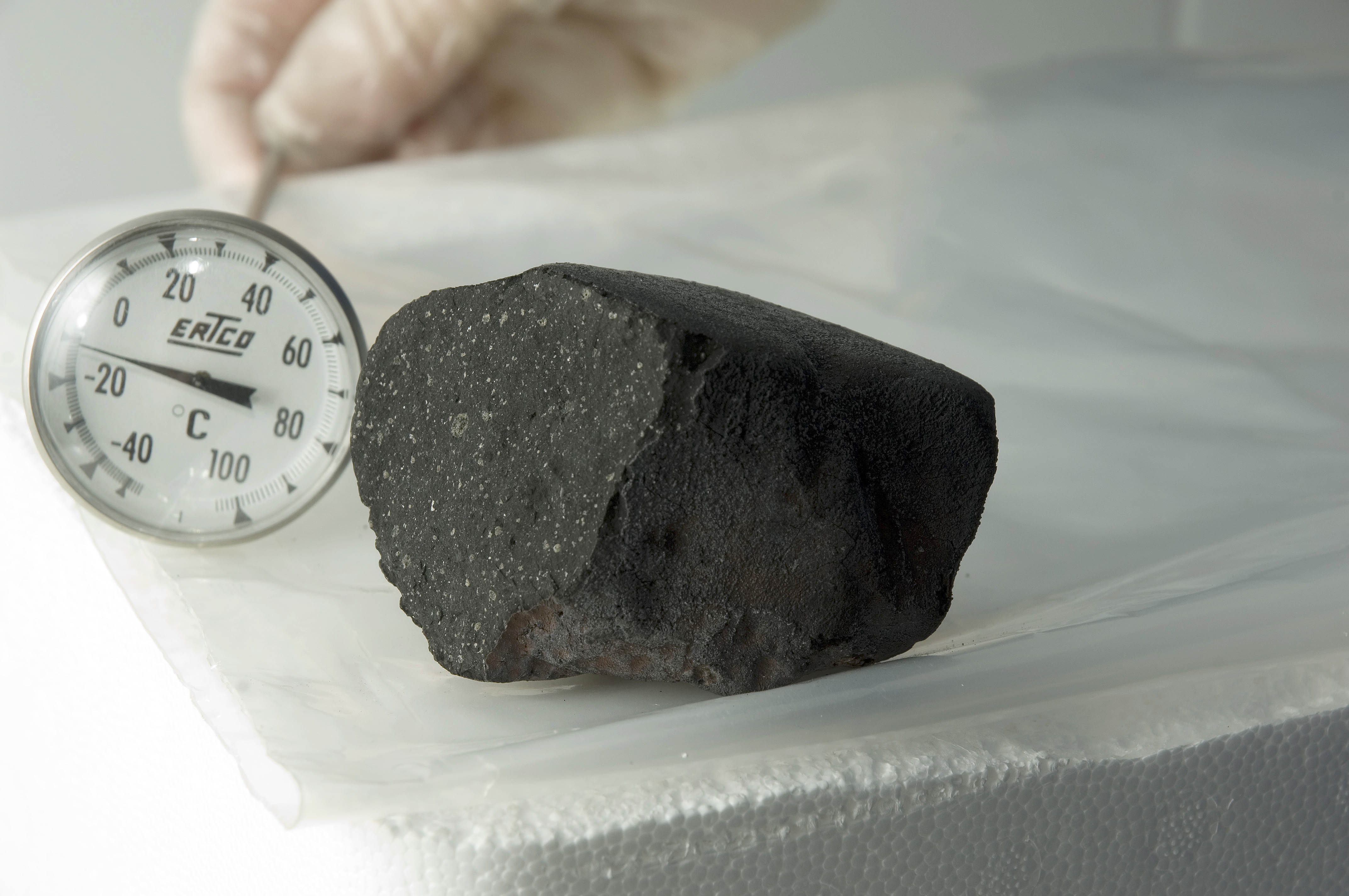
[/caption]
We’re all familiar with the hypothesis of panspermia – that life can be “seeded” from the contents of asteroids, comets and planetoids vis-a-vis meteorite impacts – but so far no direct evidence has been found. So why should we even consider meteorites to be potential parents? The truth is out there – they contain the essentials – right down to amino acids. Up until now, what we’ve recovered has been considered structured. Then along came Tagish Lake…
In January, 2000, a large meteoroid exploded in Earth’s atmosphere over northern British Columbia, Canada, resulting in a debris fall over frozen Tagish Lake. It was a rare observed fall, and the meteorites were meticulously gathered, documented and preserved in their frozen state. The reason was twofold: to preserve the integrity of the space stones and to ensure no contamination could occur either to Earth or to the specimens.
“The Tagish Lake meteorite fell on a frozen lake in the middle of winter and was collected in a way to make it the best preserved meteorite in the world,” said Dr. Christopher Herd of the University of Alberta, Edmonton, Canada, lead author of a paper about the analysis of the meteorite fragments published June 10 in the journal Science.
For meteorite collectors, we’re well aware of the value of an observed fall and equally aware of the documentation needed to make a meteorite valuable both to market and scientific study. It’s more than just writing down the date and time of the observation and where the fragments were collected. To be done properly, the field needs to be measured. Each fragment needs to be photographed in the position in which it was found. The depth measured and more. Nothing is left to speculation.
“The first Tagish Lake samples – the ones we used in our study that were collected within days of the fall – are the closest we have to an asteroid sample return mission in terms of cleanliness,” adds Dr. Michael Callahan of NASA’s Goddard Space Flight Center in Greenbelt, Md., a co-author on the paper.
What the scientists found was the Tagish Lake meteorites are rich in carbon – and contain an assortment of organic matter including amino acids. While these “building blocks of life” aren’t new to meteoritic structure, what was out of the ordinary was different pieces had greatly differing amounts of amino acids. This varies way off the beaten path.
“We see that some pieces have 10 to 100 times the amount of specific amino acids than other pieces,” said Dr. Daniel Glavin of NASA Goddard, also a co-author on the Science paper. “We’ve never seen this kind of variability from a single parent asteroid before. Only one other meteorite fall, called Almahata Sitta, matches Tagish Lake in terms of diversity, but it came from an asteroid that appears to be a mash-up of many different asteroids.”
The team set to work on the recovered fragments – identifying different minerals present in each meteorite. What they were looking for was to see how much each had been changed by the presence of water. What they found was the different fragments each had a different water signature not accounted for from their landing on Earth. Some had more interaction and others less. This alteration may explain the diversity in amino acid production.
“Our research provides new insights into the role that water plays in the modification of pre-biotic molecules on asteroids,” said Herd. “Our results provide perhaps the first clear evidence that water percolating through the asteroid parent body caused some molecules to be formed and others destroyed. The Tagish Lake meteorite provides a unique window into what was happening to organic molecules on asteroids four-and-a-half billion years ago, and the pre-biotic chemistry involved.”
How does this change the way we look at the panspermia theory? If future falls continue to show this widespread variability, scientists are going to have to be a bit more reserved in their judgements about whether or not meteorites could deliver enough bio-molecules to make the hypothesis viable.
“Biochemical reactions are concentration dependent,” says Callahan. “If you’re below the limit, you’re toast, but if you’re above it, you’re OK. One meteorite might have levels below the limit, but the diversity in Tagish Lake shows that collecting just one fragment might not be enough to get the whole story.”
While the Tagish Lake samples are undoubtedly some of the most carefully preserved specimens collected so far, there is still a possibility of contamination from both Earth atmosphere and their lake landing. But don’t simply write off these new findings just yet. In one fragment, the amino acid abundances were high enough to show they were made in space by analyzing their isotopes. These versions of elements with different masses can tell us a lot more about the story. For example, the carbon 13 found in the Tagish Lake samples is a much heavier, and less common, variety of carbon. Because amino acids prefer lighter forms of carbon, the enriched and heavier carbon 13 deposits were most likely created in space.
“We found that the amino acids in a fragment of Tagish Lake were enriched in carbon 13, indicating they were probably created by non-biological processes in the parent asteroid,” said Dr. Jamie Elsila of NASA Goddard, a co-author on the paper who performed the isotopic analysis.
The team compared their results with researchers at the Goddard Astrobiology Analytical Lab for their expertise with the difficult analysis. “We specialize in extraterrestrial amino acid and organic matter analysis,” said Dr. Jason Dworkin, a co-author on the paper who leads the Goddard laboratory. “We have top-flight, extremely sensitive equipment and the meticulous techniques necessary to make such precise measurements. We plan to refine our techniques with additional challenging assignments so we can apply them to the OSIRIS-REx asteroid sample return mission.”
We look forward to their findings!
Original Story Source: NASA / Goddard Spaceflight News.
All-Student Crew Lands at Mars Research Station
[/caption]
Headline from the future? Actually, it’s happening now, although not quite on Mars, but about as close as humans can currently get. Six college students are the latest crew to embark on a two-week stint at the Mars Desert Research Station, a simulated Mars habitat set up by the Mars Society located in the San Rafael Swell of Utah. Looking across the very Mars-like red, rocky, panoramic vistas outside the habitat, participants might think they are on the Red Planet. And this latest crew, the 99th for MDRS, will be testing a microbial detection system and an EVA optimization method using an iPad.
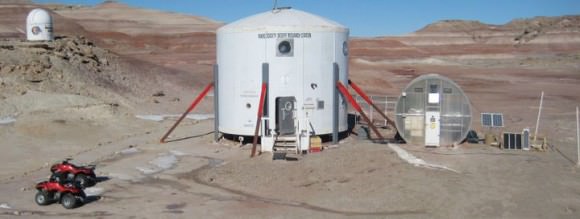
The students — all graduate students or about to be – are from different colleges but came together in the summer of 2010 at the NASA Academy at the Ames Research Center in California, a 10-week immersive research internship.
“At the NASA Academy, we worked on a group project called LAMBDA – the Life and Microbial Detection Apparatus,” participant Max Fagin, from Dartmouth University, told Universe Today. “We wanted to do some follow-up work, in looking at microbial fuel cells, which run off the metabolic activity of bacteria — technology that could be applied to sewage reclamation plants in order to generate power.”
Fagin said the technology has been around a while, but they are trying to adapt it to detect microbes in soil samples, similar to what the Viking mission did in the 1970’s.
“We put a sample into the device and based on the power that is generated you can determine whether that power is coming from microbial activity or organic activity,” Fagin said.
They finished the summer internship with a good theoretical analysis and a non-working prototype, but wanted to field test their research, as well as continue work on other individual projects.
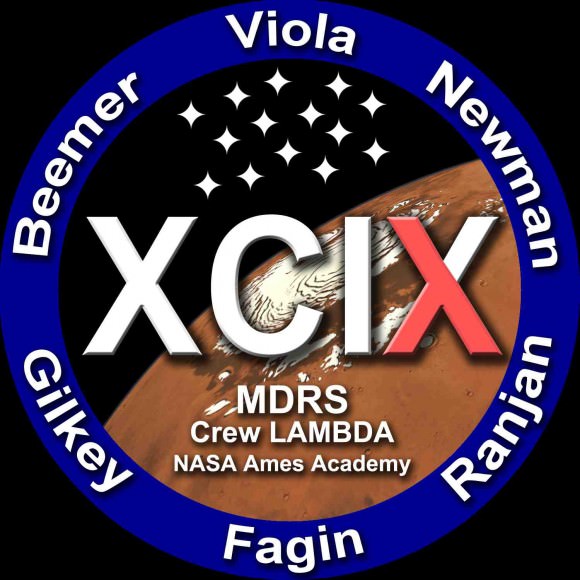
Donna Viola, a senior undergraduate at the University of Maryland, Baltimore County, had been on two crew rotations on the MDRS previously and suggested to her fellow NASA Academy team that they apply as a group to the MDRS where they could test LAMBDA in actual conditions, with actual soil samples in the field where there may be potentially extremophile forms of life to find.
The team was accepted and began their crew rotation at MDRS on January 29. They will be there until February 12, all the while in complete Mars simulation. Crew members must wear a space suit when going outside the Habitat; they eat only space-travel type food (along with vegetables grown on-site in a greenhouse); power is provided by batteries or a power generation system; and there is also a water recycling system.
Viola is the Commander, Heidi Beemer is the team geologist and Executive Commander, Kevin Newman is the Engineer, Andie Gilkey is the team scientist and Health and Safety Officer, Chief Biologist, Sukrit Ranjan is the team astronomer and Fagin is the EVA Engineer.
See the crew biographies.
14 students total were part of the NASA Ames Academy, and even though only 6 are at the MDRS, the rest are serving as ground and mission support.
The last six weeks the team has been updating the LAMBDA device and making it field worthy, integrating it with the control system, and testing it.
While at MDRS, the crew has a few other projects, such as working on a proposed combination EVA planner and EVA monitor that runs on an iPad. “It monitors the astronauts’ health, vital signs, how much energy they are consuming, whether they should speed up or slow down – it’s basically an EVA optimizer,” Fagin said.
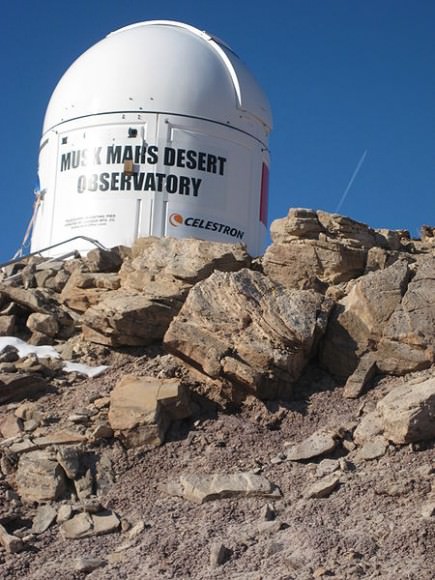
They will also fly a payload on a high altitude balloon that tests the feasibility of using balloon borne payloads on Mars. “There are no FAA regulations on Mars, so on Mars you could build a weather station on a balloon – such as on a 10 km tether and reel it in and out to get very nice vertical cuts of the atmospheric profiles of wind velocity and direction and dust profiles,” Fagin explained. “And also you could do astronomy by launching a small telescope. But we can’t do the tether part because they are here on Earth so we’ll be using a balloon and have to retrieve it.” They will also be flying a generic meteorological payloads and doing astronomical projects at the observatory on site, the Musk Observatory, which has a 14-inch telescope.
During their stay, the crew is required to send daily reports and dispatches from the commander, engineers, crew scientists, and journalists through the MDRS website which provides updates on the status of science experiments, updates on crew health and morale, and on the habitat and how it is faring. There is also a live webcam of different parts of the station.
MDRS is the second research station to be built by the Mars Society. The first was the Arctic station (FMARS) on Devon Island, built in 2000. Stations to be built in Europe (European Mars Analog Research Station / Euro MARS) and Australia (Australia Mars Analog Research Station / MARS Oz) are currently in the planning stages.
The goal of these analog research stations is to develop key knowledge, field tactics and equipment needed to prepare for the human exploration of Mars, testing habitat design features and tools, and to assess crew selection protocols. Utah is much warmer than Mars, the desert location is optimal because of its Mars-like terrain and appearance.
Find out more information on participating in the MDRS.
The first dispatches from the LAMBDA crew report how they are getting acclimated to the habitat and the equipment, as well as preparing for doing their actual science research.
Fagin said without the NASA Academy at Ames, this group of students wouldn’t be together at the MDRS today.
“This grew out of everything we did at the NASA Academy,” he said. “Without those experiences we would have no idea how to approach the situation, wouldn’t understand the science or engineering that needs to go into such a project, and certainly wouldn’t have the team-working abilities to do this if we hadn’t developed them while we were at the NASA Academy.”
Learn more about the NASA Ames Academy.
Universe Today hopes to provide an update on the LAMBDA crew’s activities.
“Astrobiology” Parody Video of Ke$ha’s “We R Who We R”
Wanna get turned on by … “Astrobiology” ?? Are we alone in the universe?
Well check out just this newly-released music video parody of Ke$ha’s hit song “We R Who We R” – “Astrobiology.”
Suspend your disbelief. It’s different. It’s cool. And it’s very clever.
And .. It’s even better the second time around when you listen to the lyrics more closely … combined with the shocking video .. Featuring beautiful maidens and alien dolls galore. Continue reading ““Astrobiology” Parody Video of Ke$ha’s “We R Who We R””
Desert RATS – On The Move
[/caption]
For some fourteen years now NASA‘s Desert Research and Technology Studies (Desert RATS) team has been testing out the viability of many of NASA’s vehicles, space suits, habitats and robotic systems in extreme environments. Like their durable name-sake, the Desert RATS have proven to be resilient and flexible, adapting to the changing NASA environment. When it was announced that NASA would move away from the Constellation Program and toward other objectives such as asteroids and possibly Mars – the Desert RATS picked up the challenge and modified their regimen to reflect this change.
Testing this year will take place from Aug. 31 until Sept. 15 and will shakedown many new design concepts. The former Electric Lunar Rovers, now dubbed Space Exploration Vehicles will be tested at the site requiring simulated astronauts to live in these vehicles for a week.
No Desert RATS expedition would be incomplete without some incredible robots to assist their human companions. There are the Tri-ATHLETEs (Terrain Hex-Legged Extra-Terrestrial Explorer) – these wheeled, spidery creations have six independent ‘legs’ each with a wheel at the base and can be fitted with different ‘tops” for each mission. Robonaut 2, one of NASA’s new robotic rock-stars, has been converted into a four-wheeled variant dubbed Centaur 2 and will be tested this year. This variation could be a potential mode of transport for NASA.
However, this year’s rotation is all about the “hab.” The Habitat Demonstration Unit (HDU) Project is an inter-agency project consisting of NASA architects, scientists and engineers. These groups are working to develop living quarters, workspaces, and laboratories for future space missions, working under the “build a little – test a little” philosophy. This area will serve as a laboratory, a place for maintenance and a staging area in the event of a medical emergency.
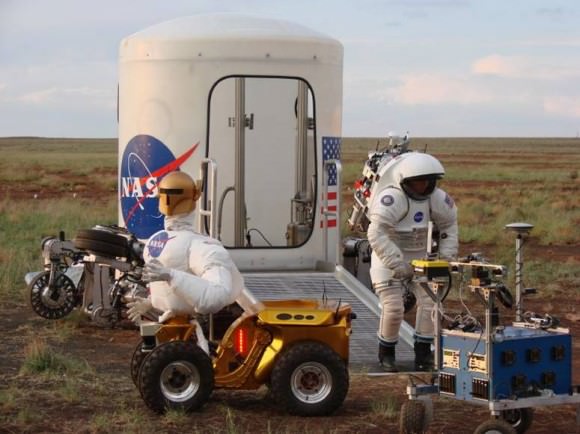
“This allows us to have far greater flexibility,” said Tracy Gill, NASA’s Deputy Project Manager for the habitat element of this project. “These habitats are currently in the process of being developed further to make them even more adaptable.”
NASA is working with the National Space Grant Foundation to develop an inflatable “loft” that will be attached to the HDU. This will mean that astronauts won’t have to don a space suit to travel from their living quarters to where they work – they would simply have to go “upstairs.” In an effort to promote science, technology, engineering and math (known as STEM) in college-age students, the X-Hab Academic Innovation Competition is working to sponsor development of these inflatable habitat concepts. The goal is for senior and graduate-level design students to design, manufacture, assemble, and test an inflatable loft that will be integrated on top of an existing NASA built hard shell prototype.
As with any year the Desert RATS test out new concepts, this year promises to display many futuristic ideas that one day may be used in the real world(s). This year is slightly different however, in that the elements being tested are designed to be readily adaptable toward whatever NASA will eventually be called to do. During the Apollo era, astronauts were trained by “the King” – Farouk El-Baz. El-Baz worked with the astronauts so that they would be intimately familiar with the lunar surface, that they had the training and tools to get the job done. These annual event – would make “the King” – proud.
Europa Analog Deep-Sea Vents Discovered in the Caribbean
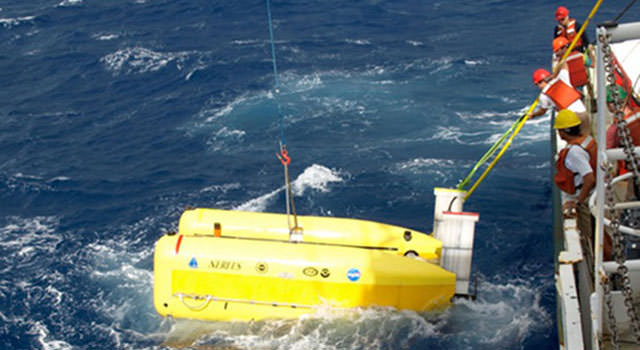
[/caption]
White sand, blue water, sunny skies, pina coladas. When you think of “extreme environments” I doubt the Caribbean is high on your list. But a team of scientists from Woods Hole Oceanographic institute and NASA’s Jet Propulsion Laboratory, exploring the 68-mile-long Mid-Cayman rise deep beneath the surface of the Caribbean, have discovered the deepest known hydrothermal vent in the world, along with two other distinct types of vents.
The mid-Cayman rise is a much smaller version of the mid-ocean ridge system, a chain of submarine mountains that encircles the globe. These ridges form in locations where tectonic plates are pulling apart, allowing mantle rocks to melt and emerge at the surface as lava. Seawater, percolating through the hot rocks at these spreading centers, is superheated and emerges at vents, bearing a rich bounty of dissolved nutrients to support thriving ecosystems that can live without any sunlight.
“This was probably the highest-risk expedition I have ever undertaken,” said chief scientist Chris German, a Woods Hole Oceanographic Institution geochemist who has pioneered the use of autonomous underwater vehicles to search for hydrothermal vent sites. “We know hydrothermal vents appear along ridges approximately every 100 kilometers [62 miles]. But this ridge crest is only 100 kilometers long, so we should only have expected to find evidence for one site at most. So finding evidence for three sites was quite unexpected – but then finding out that our data indicated that each site represents a different style of venting – one of every kind known, all in pretty much the same place – was extraordinarily cool.”
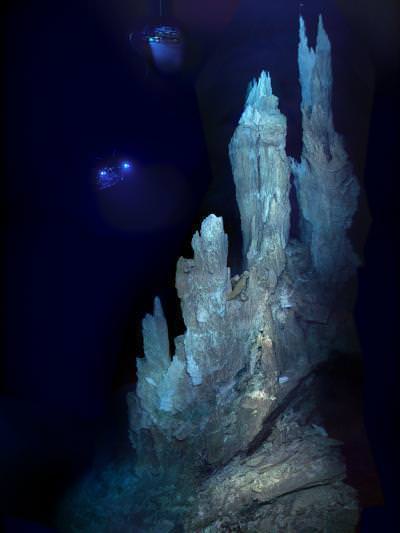
In addition to the deepest hydrothermal vent yet discovered, at a depth of 5,000 meters (16,400 feet), the team also found a shallower low-temperature vent. Only one other vent of this type has been discovered: the famous “Lost City” vent in the Atlantic.
“We were particularly excited to find compelling evidence for high-temperature venting at almost 5,000 meters depth,” said Julie Huber, a scientist in the Josephine Bay Paul Center at the Marine Biological Laboratory in Woods Hole. “We have absolutely zero microbial data from high-temperature vents at this depth.”
The ecosystems encrusting the deep sea vents on the mid-Cayman rise provide valuable clues to how life could arise and thrive elsewhere in the solar system. “Most life on Earth is sustained by food chains that begin with sunlight as their energy source. That’s not an option for possible life deep in the ocean of Jupiter’s icy moon Europa,” said JPL co-author Max Coleman.
With an airless sky, intense radiation, icy crust, and no pina coladas, the surface of Europa is about as different from the Caribbean as you can get. But deep on the sea floor, they may be remarkably similar.
“Organisms around the deep vents get energy from the chemicals in hydrothermal fluid, a scenario we think is similar to the seafloor of Europa,” Coleman said. “This work will help us understand what we might find when we search for life there.”

